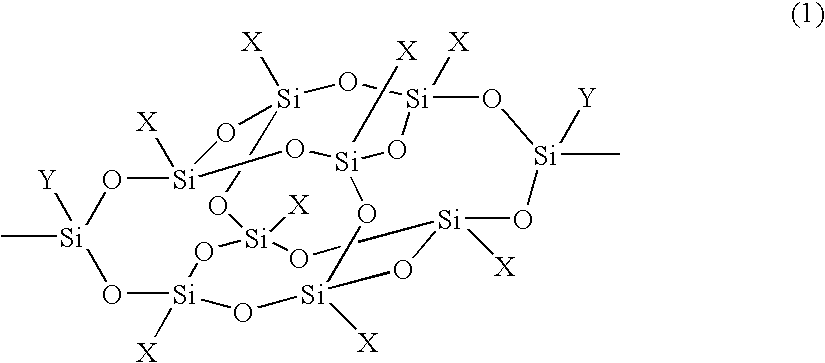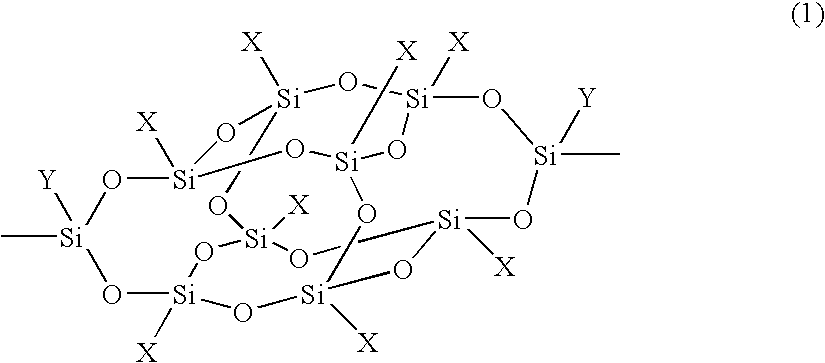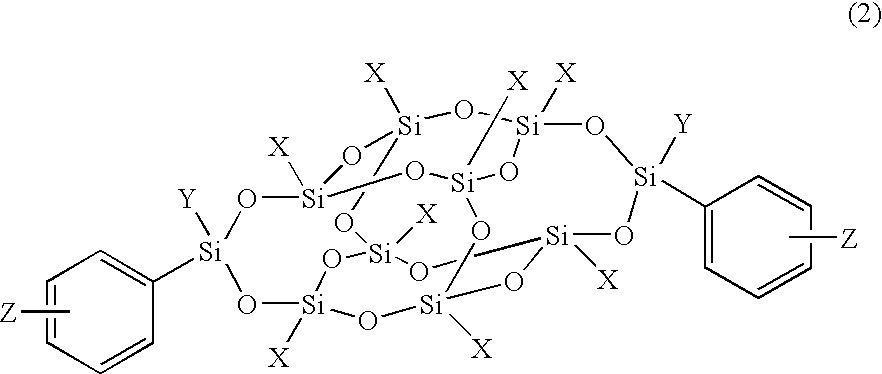Organosilicon compound and polymer having a cage-type silicon skeleton
a technology of organic silicon and compound, applied in the field of organic silicon compound and polymer having a cage-type silicon skeleton, can solve the problems of limited number of compounds that can be easily synthesized and isolated, limited number of commercially available compounds among such compounds, and existing psq derivatives, etc., and achieve excellent heat resistance and mechanical strength.
- Summary
- Abstract
- Description
- Claims
- Application Information
AI Technical Summary
Benefits of technology
Problems solved by technology
Method used
Image
Examples
example 1
[0119] Synthesis of organosilicon compound represented by the formula (2) in which X is phenyl, Y is methyl, and Z is —C≡C—Ph (Compound 3);
[0120] Hereinafter, detailed procedures are shown by each step.
(1) Synthesis of the Compound 2
[0121] 2.0 g (7.4 mmol) of 4-bromophenylmethyldichlorosilane (synthesized according to Kohama et al., Japanese Journal of Chemistry, vol. 79, eleventh edition, p. 1307 (1958)) was added dropwise at room temperature to a solution prepared by suspending 3.88 g (3.36 mmol) of a double-decker sodium salt (Compound 1) into tetrahydrofuran (hereinafter, THF), and then the whole was stirred for 3 hours. Water was added to the reaction system, followed by twice of extraction with toluene. An organic layer was dried with magnesium sulfate, and then concentrated by means of a rotary evaporator. The resultant white solid was recrystallized from toluene to yield 2.57 g (1.75 mmol) of the Compound 2 as a white solid (52% yield, melting point: 278.2° C., Rf=0.3 (...
example 2
[0128] Synthesis of the organosilicon compound represented by formula (2) in which X is phenyl, Y is methyl, and Z is hydroxyl (Compound 5);
[0129] Hereinafter, detailed procedures are shown by each step.
(1) Synthesis of Compound 4
[0130] A THF solution of 4-benzyloxyphenylmethyldichlorosilane (synthesized according to JP2000-159714A) was added dropwise at room temperature to a solution prepared by suspending 3.86 g (3.33 mmol) of the Compound 1 into 20 ml of THF, and then the whole was stirred for 3 hours. Water was added to the reaction system, followed by twice of extraction with toluene. An organic layer was dried with magnesium sulfate, and then concentrated by means of a rotary evaporator. The resultant oily matter was subjected to silica gel column chromatography. The resultant solid was recrystallized from toluene to yield 1.58 g (1.00 mmol) of the Compound 4 as a white solid (30.3% yield, melting point: 198.4° C., Rf=0.206 (hexane:ethyl acetate=9:1)).
[0131]1H-NMR (CDCl3...
example 3
[0137] Synthesis of the organosilicon compound represented by formula (2) in which X is phenyl, Y is methyl, and Z is vinyl
[0138] 2.4 g of triethylamine were added to a solution prepared by suspending 9.3 g (8.0 mmol) of the Compound 1 into 80 ml of THF, and the whole was stirred at room temperature. 5.2 g (2.4 mmol) of styrylmethyldichlorosilane (synthesized according to JP59-126478A) were added dropwise at room temperature to the obtained solution, followed by stirring for 5 hours. The precipitated salt was filtered out, and the filtrate was concentrated under reduced pressure. The concentrate was dissolved into 30 ml of THF, and the salt was filtered out again. The filtrate was concentrated and loaded into 250 ml of methanol. The precipitated target substance was filtered out and dried under reduced pressure to yield 7.9 g (5.8 mmol) of a white solid (73% yield).
[0139]1H-NMR (CDCl3); δ=0.51 (6H, s), 5.25, 5.27 (2H,dd), 5.70, 5.75 (2H,dd), 6.63-6.72 (2H, m), 7.02-7.61 (48H, m). ...
PUM
| Property | Measurement | Unit |
|---|---|---|
| Liquid crystal transition temperature | aaaaa | aaaaa |
| aaaaa | aaaaa |
Abstract
Description
Claims
Application Information
 Login to View More
Login to View More - R&D
- Intellectual Property
- Life Sciences
- Materials
- Tech Scout
- Unparalleled Data Quality
- Higher Quality Content
- 60% Fewer Hallucinations
Browse by: Latest US Patents, China's latest patents, Technical Efficacy Thesaurus, Application Domain, Technology Topic, Popular Technical Reports.
© 2025 PatSnap. All rights reserved.Legal|Privacy policy|Modern Slavery Act Transparency Statement|Sitemap|About US| Contact US: help@patsnap.com



